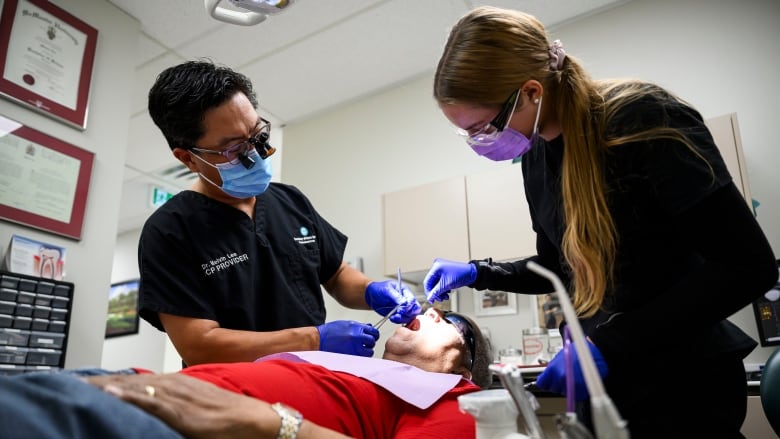Looking for access to subsidized dental care? It might depend on where you live
Dentists' rates of participation in the Canadian Dental Care Plan vary widely across the country

Nearly three quarters of dentists are accepting patients through the new Canadian Dental Care Plan (CDCP)but dentist participation rates still vary widely from province to province.
Data obtained by CBC News shows theCDCP participation rate fordentists is lowest in New Brunswick, PEI, Nunavut, Yukon and the Northwest Territories. In New Brunswick, only 40 per cent of dentists are accepting CDCP patients. In the three territories, only 38 per cent of dentists takepart inthe program.
The provincial and territorial data was provided to CBC News after four weeks of repeated requests to Health Canada and Health Minister Mark Holland's office.
It's not clear how hard it is for patients outside of cities to find dental clinics that are accepting CDCP patients. Data on the number ofparticipating dentists in rural and remote regions of Canada is not available,Holland's spokesperson Matthew Kronberg told CBC News.
"I think it's a bunch of hooey," said Susan Francis, a 69-year-old who lives in thesmall community of Kindersley, Sask.
"I think that's a no-brainer to try to figure out where it's being used and where it isn't."
Francis said she expects to drive more than two hours to Saskatoon to a dentist willing to accept her through the CDCP, since no nearby clinic will.
"It's really disappointing for me," she said. "I get free dental care, woo-hoo, but it's going to cost me gas money.
"It needs to be accessible for all people, not just people that live in urban centres."
Oral health-care professionals voluntarily take part in the new national dental insurance program, either by signing up as a registered provider or by processing patient claims on a case-by-case basis.
The low participation rate amongdentists in New Brunswick is likely due to their thinly staffed offices, saidPaul Blanchard, executive director of the New Brunswick Dental Society.
"We've had an increase in population here, pretty significantly since COVID, and we have an aging population of dentists," Blanchard said, adding that New Brunswick has one of the worst dentist-to-patient ratiosin the country.
"A significant portion of dental clinics are not able to accept new patients today," he said. "And this program isn't fully rolled out."
Only 13 dentists offering CDCP in territories
Right now, applications for the CDCP are open to seniors, children under the age of 18 and people who receive the federal disability tax credit. The rest of the eligible adult population will be able to apply for coverage in January 2025.
Holland's office said that, so far, 2.3 million Canadians have been approved for coveragebut that's less than a third of the 9 million the program expects to cover starting next year.
According to the Health Canada data, more than 500,000 Canadians have received care through the new program since it began in May. The majority of claims were filed in Ontario and Quebec, where more than 11,000 dentists are accepting CDCP patients.
In the three territories, meanwhile, only 51 claims have been filed to date and only13 dentists are accepting patients through the plan.
"I'm not surprised," said Dr. Steven Partyka, an Iqaluit dentist and president of the Northwest Territories and Nunavut Dental Association.
Just two dental offices are participating in the CDCP onein Nunavut and one in the Northwest Territories.
Partyka said many dentists in the region don't want to take part because they're short-staffed and worry about the extra administrative work.
He added many dentists in the territories have had bad experiences with trying to process claims through another major national dental insurance plan the Non-Insured Health Benefits (NIHB), which provides dental coverageto uninsured First Nations and Inuit.
"A lot of dentists do not have a warm, fuzzy feeling when it comes to NIHB because of what has occurred in the past as far as the administrative burden that is placed on a dental office," Partyka said.
The low CDCP uptake in the regionmight also reflect the fact that, due to the high cost of living in the North, many people in the territories have access to other public and private dental programs created tooffsetthose costs.
The CDCPmarks amassive expansion for Canada's universal health-care system. It's expected to cost taxpayers $13 billion over the next five years and to eventually cover one in four Canadians who don't have access to private dental insurance plans and have household incomes under $90,000.
The program was a key element ofthe recently terminated confidence-and-supplyagreement between the Liberal government and the federal NDP. The New Democrats agreed to vote with the Liberals in the House of Commons on key legislation in return for the creation of new social programs like national dental care and pharmacare.
Do you have questions about how Canada's new dental care plan may affect you? Send an email to ask@cbc.ca.












_(720p).jpg)


 OFFICIAL HD MUSIC VIDEO.jpg)
.jpg)



























































































